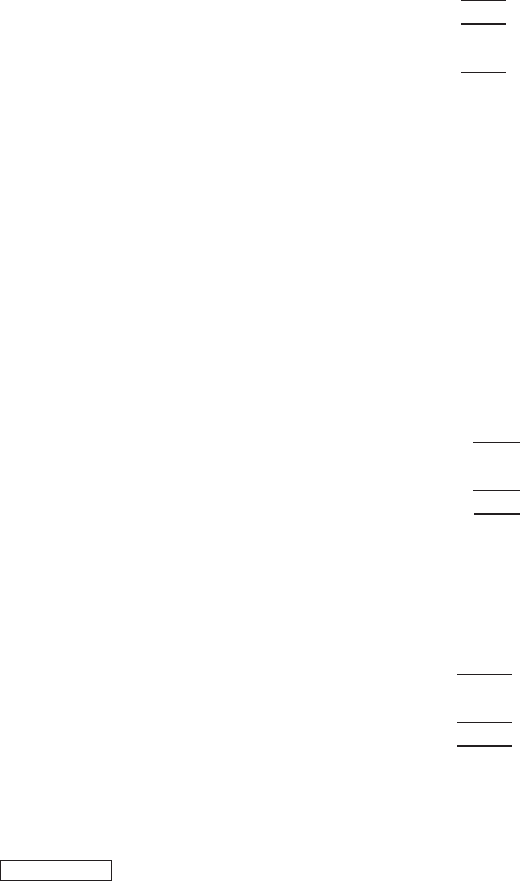CIMA CO2 Official Learning System - Fundamentals of Financial Accounting
Подождите немного. Документ загружается.


STUDY MATERIAL C2
510
THE INTERPRETATION OF FINANCIAL STATEMENTS
14.6 Liquidity ratios
These are also known as solvency ratios , as they refer to the ability of the business to pay its
payables in the short term.
There are two main liquidity ratios.
14.6.1 The current ratio
This is also known as the working capital ratio, as it is based on working capital or net
current assets. It is a measure of the liquidity of a business that compares its current assets
with those payables due to be paid within 1 year of the statement of fi nancial position date
(otherwise known as current liabilities). It is calculated as:
Current assets
Current liabilities
9 701
1 086
891
,
,
.:
N
otice how the ratio is expressed, as a comparison of assets with liabilities. The ratio can
also be stated as:
Current assets : current liabilities
The importance of this ratio is the information it gives about the liquidity of a business.
Current liabilities all have to be settled in cash within a reasonably short space of time.
Does the company have suffi cient liquid resources to do this? Clearly, its cash and bank
balances are liquid; receivables should convert into cash quite soon; and inventories will
presumably soon be sold, again eventually generating cash. The calculation tells us that the
company has $8.90 in current assets with which to pay every $1 of its current liabilities.
A high ratio, such as the one in our example, means that current assets are easily suf-
fi cient to cover current liabilities. A ratio of below one – meaning that current liabilities
exceed current assets – could imply danger of insolvency. It used to be thought that a
ratio of 2:1 was ideal, but this depends on the type of business and its reliance on credit
transactions.
Although a high ratio gives comfort to payables, it may mean that the company is hold-
ing more in current assets than it requires in the short term. This is wasteful, as current
assets rarely earn income – inventories need to be sold in order to produce profi ts, receiva-
bles will not pay more than the amount outstanding, and bank balances may earn only
very small amounts of interest. Indeed, a company with a high level of inventories might
indicate diffi culty in selling them, while a high level of receivables might indicate poor
credit control.
14.6.2 The quick ratio
This is also known as the acid test ratio and is calculated by:
Current assets excluding inventories
Current liabilities
8,2276
1 086
100 7 61
,
.:
or it can be expressed as:
C
urrent assets excluding inventories : current liabilities

511
FUNDAMENTALS OF FINANCIAL ACCOUNTING
THE INTERPRETATION OF FINANCIAL STATEMENTS
This is similar to the current ratio, but takes the more prudent view that inventories
may take some time to convert into cash, and therefore the true liquidity position is meas-
ured by the relationship of receivables and cash only to current liabilities. The calculation
tells us that the company has $7.60 in ‘ quick ’ assets with which to pay each $1 in its cur-
rent liabilities. Again, a very high ratio is very comforting, but may be wasteful as men-
tioned above. Generally, a ratio of 1:1 is considered ‘ ideal ’ but many retail companies with
very regular cash sales have very low ratios, due to their lack of receivables.
A low ratio might need further investigation before conclusions can be drawn, for exam-
ple, if the current liabilities fi gure includes payables not due for payment until well into
the next accounting period (e.g. income tax), the fi gure may be distorted.
14.7 Efficiency ratios
These are also referred to as use of assets ratios. They measure the effi ciency of the manage-
ment of assets, both non-current and current.
14.7.1 Asset turnover ratios
These ratios compare the assets with the sales revenue (turnover) that they have earned.
The end result is often expressed in money value to represent the value of sales revenue for
each $1 invested in those assets. The formula is:
Sales revenue
Assets
........... $
The calculation can be per
formed on any combination of assets, from total net assets to
individual groups of assets, such as plant and machinery.
Sales: total capital employed (capital turnover)
This is the sales revenue generated per $1 of average total capital employed.
Sales revenue
Average total capital employed
23 636
18 925
,
,
$11 249,
(S
ee Section 14.5.4 for the calculation of average total capital employed).
The result tells us that we generated $1.249 in sales for every $1 invested in net assets.
Sales: non-current assets (non-current asset turnover)
This is the sales revenue generated per $1 of non-current assets.
Sales revenue
Non-current assets
23 636
14 135
1 672
,
,
£.
This tells us that for ever
y $1 invested in non-current assets, sales revenue of $1.672 was
earned. This fi gure is meaningless on its own – it is commonly compared with previous
years ’ results, as comparison between fi rms is less useful.
14.7.2 Inventories days
Inventories may be analysed by calculating the ratio of inventories to cost of sales, and
then multiplying by the number of days in a year to give inventories days.

STUDY MATERIAL C2
512
THE INTERPRETATION OF FINANCIAL STATEMENTS
The calculation is:
Inventories
Cost of Sales
inventories days365
1 425
8 799
365 59
,
,
days
This
fi
gure gives the number of days that on average an item is in inventories before it is
sold; this may alternatively be expressed as the number of days a fi rm could continue trad-
ing if the supply of goods ceased.
The calculation may also use average inventories:
1 325
8 799
365 55
,
,
days
This tells us that in the past y
ear, this was the average inventories days. By using the inven-
tories at the end of the year, this tells us what the inventories days will be in the future,
assuming cost of sales remains the same.
The number of inventories days is relevant to the context of the business; in a manu-
facturing company, it will approximate to the production cycle and in a cream cake shop
to 1 day!
If inventories days are relatively high, this may indicate that inventories are too high and
there is additional fi nance tied up in inventories which could perhaps be used more effec-
tively elsewhere. If cash is paid out when the inventories are purchased, but the cash does
not come back in until the inventories are sold to a customer, then this temporary negative
cash fl ow will have to be fi nanced by the company. Moreover, if the inventories are sold on
credit terms and the customer does not pay for, say 1 month, then the delay in getting the
cash back in is even longer.
If the inventories are too low, this may show an overzealous application of the ‘ just-in-
time ’ concept and consequential risks of running out of inventories. It may also indicate a
company meeting a cash fl ow crisis by running down inventories levels.
Inventories days needs to be compared to other companies and compared to previous
years in the same company. Increasing inventories days may be investigated further by sep-
arately analysing raw materials (RM), work in progress (WIP) and fi nished goods (FG) to
cost of goods sold. An increase in RM days may indicate mismanagement in the buying
department; an increase in WIP may indicate production delays. If FG days increase, this
may be a sign of decline in demand for the product and an increase in obsolete items.
The inventories ratio may also be expressed as the number of times an item turns over
in a year – that is, how many times it is bought and sold during the year.
Inventories turnover is calculated as:
Cost of sales
Average inventories
times
8 799
1 325
66
,
,
.
Y
ou should note here that the word ‘ turnover ’ is being used to mean ‘ turn over ’ and is not
referring to turnover, as in sales.

513
FUNDAMENTALS OF FINANCIAL ACCOUNTING
THE INTERPRETATION OF FINANCIAL STATEMENTS
14.7.3 Receivables days
This is a measure of the average time taken by customers to settle their debts. It is calculated by:
Receivables
Sales
days 365
542
23 636
365 8
,
Where details ar
e available, credit sales only should be considered.
‘ The sales fi gure will exclude sales tax but receivables will include sales tax, and so
strictly speaking the fi gure is not comparing like-with-like. This sales tax on sales or receiv-
ables is not usually known and so this is inevitable. However, if the sales tax is known, then
the fi gures should be adjusted so that both either include, or exclude, sales tax.
The result of this calculation should be compared with the number of days ’ credit nor-
mally allowed by the business to its customers. If it appears that customers are taking
longer to pay than they should do, it may be necessary to take remedial action.
As with inventories days, a slowing down in the speed of collecting debts will have a
detrimental effect on cash fl ow. On the other hand, it may be that the business has deliber-
ately offered extended credit in order to increase demand.
14.7.4 Payable days
This is a measure of the average time taken to pay suppliers. Although it is not strictly a
measure of asset effi ciency on its own, it is part of the overall management of net current
assets. It is calculated by:
Payable
Purchases
days 365
1 086
8 999
365 44
,
,
The pur
chases fi gure should exclude any cash purchases, if this information is available;
where there is no purchases fi gure available the best alternative is to use cost of sales as
the denominator. Similarly, payables should include only trade payables, not payables for
expenses or non-current assets.
The purchases fi gure will exclude sales tax but payables will include sales tax, and so
strictly speaking the fi gure is not comparing like-with-like. The sales tax on purchases or
payables is not usually known and so this is inevitable. However, if the sales tax is known,
then the fi gures should be adjusted so that both either include, or exclude, sale tax.
The result of this ratio can also be compared with the receivables days. A fi rm does not
normally want to offer its customers more time to pay than it gets from its own suppliers,
otherwise this could affect cash fl ow. Generally, the longer the payables payment period,
the better, as the fi rm holds on to its cash for longer, but care must be taken not to upset
suppliers by delaying payment, which could result in the loss of discounts and reliability.
It is important to recognise when using these ratios that it is the trend of ratios that is
important, not the individual values. Payment periods are longer in some types of organi-
sation than in others.
14.7.5 Total working capital ratio
This measures the total length of time for which working capital is tied up in inventories,
receivables and payables, before becoming available for use. It is the total of the number

STUDY MATERIAL C2
514
THE INTERPRETATION OF FINANCIAL STATEMENTS
of inventories days, receivables days, less payables days. From the preceding three sections,
you can see that this is:
Number of days – inventories 59
Number of days – receivables 8
Less number of days – payables (44)
Total working capital days 23
This tells us that it takes, on average, 23 days in which to sell the inventories, receive pay-
ment from receivables and pay the payables. The total of 23 days may not seem too lengthy
for a manufacturing business, but it does indicate the level of working capital needed in
order to fi nance the ordinary activities of the business, which may result in the need for an
overdraft or other sources of fi nance.
14.8 Capital structure ratios
Different fi rms have different methods of fi nancing their activities. Some rely mainly on
the issue of share capital and the retention of profi ts; others rely heavily on loan fi nance;
most have a combination of the two.
14.8.1 The gearing ratio (or leverage ratio)
Gearing is a measure of the relationship between the amount of fi nance provided by exter-
nal parties (e.g. debentures) to the total capital employed. It is calculated by:
Debt
Total capital employed
100
4 500
22 750
100 20
,
,
%
Y
ou should recall from the discussion above regarding the return on total capital employed
(ROCE), that total capital employed is equity plus debt. This ratio has been calculated based
on the capital employed at the date of the statement of fi nancial position. An alter native
would be to use the average capital employed and average loan capital during the year.
The more highly geared a business, the more profi ts that have to be earned to pay the
interest cost of the borrowing. Consequently, the higher the gearing, the more risky is the
owner’s investment. Remember that dividends do not have to be paid out if the directors
decide not to declare them, so there is reduced risk with low-geared companies, especially
in times when profi ts are falling. On the other hand, a highly geared company might be
more attractive to shareholders when profi ts are rising, because there are fewer of them to
share out those profi ts.
An alternative method of calculating gearing is known as the debt: equity ratio. In this
case, the loan capital is expressed as a percentage of equity capital.
In this example, it would be:
Debt
Equity
4 500
18 250
100 25
,
,
%

515
FUNDAMENTALS OF FINANCIAL ACCOUNTING
THE INTERPRETATION OF FINANCIAL STATEMENTS
14.8.2 Interest cover
Connected to the gearing ratio is a measure of the number of times that the profi t is able
to ‘ cover ’ the fi xed interest due on long-term loans. It provides lenders with an idea of the
level of security for the payment. The formula is:
Operating profit
Interest payable
times
9100
450
20
,
This sho
ws lenders that their interest is covered 20 times by the current profi ts. This would
normally be a fairly comfortable level, but of course, it is future profi ts that will determine
the actual level of cover.
14.9 Ratio analysis for sole traders
All of the above ratios can be calculated for sole traders, as well as for limited companies.
Exercise 14.1
Give the formulae for the following ratios:
(a) Return on capital employed (ROCE),
(b) Gross profi t margin,
(c) Operating profi t margin,
(d) Return on equity (ROE),
(e) Non-current assets turnover,
(f) Inventories days,
(g) Receivables days,
(h) Payables days,
(i) Current ratio,
(j) Quick ratio,
(k) Gearing ratio.
Solution
Refer to the formulae above for the solutions.
14.10 Summary
This very important chapter is one worth spending time over. In a computer-bases assess-
ment, not only will you be expected to calculate ratios, but you may need to be able to do
any or all of the following:
●
explain what the ratio attempts to show;
●
discuss the results of your calculations;
●
suggest possible reasons for good/poor results or differences from previous years, other
companies or expectations.
Although ratios are a useful additional guide to decision-making, they are also very diffi -
cult to interpret fully without additional information.
STUDY MATERIAL C2
516
THE INTERPRETATION OF FINANCIAL STATEMENTS
Before calculating any ratios the nature of the business should be considered. The fol-
lowing list of questions is a useful starting point:
●
What is the nature of its business?
●
Does it need a lot of assets to operate?
●
How has it obtained its funding (shareholders ’ capital, loan capital or internally gener-
ated profi ts)?
●
Does it have a high or low operating profi t margin on its business?
●
Does it have high or low turnover in relation to the amount of capital that is tied up
in the organisation? (High-margin companies will normally have slower rates of sales/
t urnover because they usually charge higher prices and/or operate in premium segments
of a market.)
●
Does the company appear to be fi nancially unstable (i.e. does it have excessive debts in
relation to its assets)?
●
Do the level of inventories or any other asset, or number of employees appear to be too
high or too low to support the organisation’s level of activity/sales?
●
Is there any information to tell whether the business is more or less effi cient/profi table
than other competitors in the same industry?
The answers to these questions and to others that are naturally associated with them are
key to understanding how an organisation is currently performing and how it is likely to
perform in the future. Trends in these indicators are of interest to internal managers and
accountants, and also to external users. Examples of external users are:
●
investors and potential investors use this type of information to decide whether to buy,
sell or hold shares in a particular company;
●
lenders and suppliers wish to know about the solvency of an enterprise and its ability to
repay loans or debts incurred in relation to the supply of materials or services;
●
governments charged with the responsibility for framing fi scal policy or industrial policy
in different sectors of the economy will fi nd much of interest in them. Many of the
accounting fi gures are used to compile national statistics on industrial output, gross
national product (GNP), wage levels and infl ation trends.
External sources of comparative information will usually be industry averages compiled by
government agencies or independent industry groups. These are readily available on the
Internet.

517
Question 1 Multiple choice
1.1 Given a selling price of $350 and a gross profi t mark-up of 40 per cent, the cost
price would be:
$...............
1.2 Sales are $110,000. Purchases are $80,000. Opening inventories are $12,000.
Closing inventories are $10,000. Inventories days using average inventories are:
days
1.3 A business commenced with a bank balance of $3,250; it subsequently purchased
goods on credit for $10,000; gross profi t mark-up was 120 per cent; half the goods
were sold for cash, less cash discount of 5 per cent; all takings were banked. The
resulting operating profi t was:
$...............
1.4 The rate of inventories turnover is six times where:
(A) sales are $120,000 and average inventories at selling price is $20,000.
(B) purchases are $240,000 and average inventories at cost is $40,000.
(C) cost of goods sold is $180,000 and average inventories at cost is $30,000.
(D) net purchases are $90,000 and closing inventories at cost is $15,000.
1.5 The formula for calculating inventories days is:
(A) cost of goods sold/inventories 365.
(B) inventories/purchases 365.
(C) cost of goods sold/inventories.
(D) inventories/cost of goods sold 365.
1.6 A business operates on a gross profi t margin of
33
1
3
per cent. Gross profi t on a sale
was $800, and expenses were $680. The operating profi t margin is:
per cent.
Revision Questions
14

THE INTERPRETATION OF FINANCIAL STATEMENTS
REVISION QUESTIONS C2
518
1.7 A business has the following trading account for the year ending 31 May 20X8:
$ $
Sales 45,000
Opening inventories 4,000
Purchases 26,500
30,500
Less : closing inventories (6,000)
(24,500)
Gross profi t 20,500
Its average inventories days for the year is:
days
1.8 A company’s gearing ratio would rise if:
(A) a decrease in long-term loans is less than a decrease in equity.
(B) a decrease in long-term loans is more than a decrease in equity.
(C) interest rates rose.
(D) dividends were paid.
1.9 A company has the following details extracted from its statement of fi nancial position:
$’000
Inventories 1,900
Receivables 1,000
Bank overdraft 100
Payables 1,000
Its liquidity position could be said to be:
(A) very well controlled, because its current assets far outweigh its current
liabilities.
(B) poorly controlled, because its quick assets are less than its current liabilities.
(C) poorly controlled, because its current ratio is signifi cantly higher than the
industry norm of 1.8.
(D) poorly controlled, because it has a bank overdraft.
1.10 The gross profi t mark-up is 40 per cent where:
(A) sales are $120,000 and gross profi t is $48,000.
(B) sales are $120,000 and cost of sales is $72,000.
(C) sales are $100,800 and cost of sales is $72,000.
(D) sales are $100,800 and cost of sales is $60,480.
1.11 Revenue reserves would decrease if a company:
(A) sets aside profi ts to pay future dividends.
(B) transfers amounts into ‘ general reserves ’ .
(C) issues shares at a premium.
(D) pays dividends.

THE INTERPRETATION OF FINANCIAL STATEMENTS
519
FUNDAMENTALS OF FINANCIAL ACCOUNTING
1.12 A company has the following current assets and liabilities at 31 October 20X8:
$’000
Current assets
Inventories 970
Receivables 380
Bank 40
1,390
Current liabilities
Payables 420
When measured against accepted ‘ norms ’ , the company can be said to have:
(A) a high current ratio and an ideal acid test ratio.
(B) an ideal current ratio and a low acid test ratio.
(C) a high current ratio and a low acid test ratio.
(D) ideal current and acid test ratios.
1.13 Your company’s income statement for the year ended 30 September 20X8 showed
the following:
$’000
Operating profi t 1,200
Interest (200)
P r o fi t before tax 1,000
Income tax (400)
P r o fi t for the period 600
Its statement of fi nancial position at 30 September 20X7 showed the following:
$’000
Share capital 8,000
Retained earnings 1,200
9,200
10% debenture 2,000
11 , 200
Return on average capital employed (ROCE) for the year ended 30 September
20X8 is:
per cent
